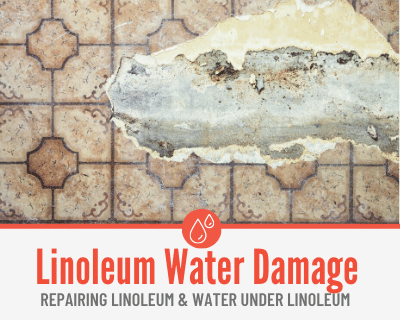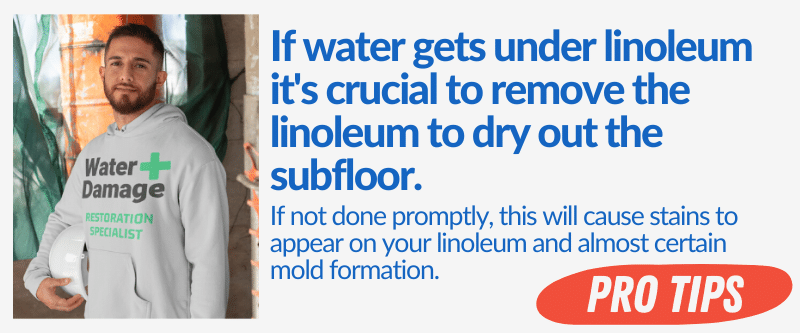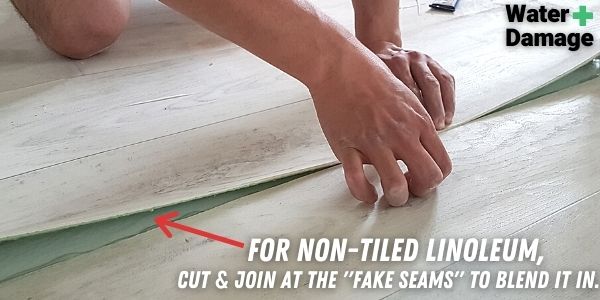If you’ve discovered water on your linoleum flooring, should you be worried?
In this guide you will learn:
- If water can damage Linoleum,
- How To Dry out & Remove Stains from Linoleum,
- How to Repair Water Damaged Linoleum Floors,
- How to deal with Water UNDER your Linoleum.

Linoleum is prone to water damage, which makes it crucial to take care of any potential leaks before lasting – and possibly dangerous – damage is able to occur.
Is Linoleum Waterproof?
No, Linoleum is not waterproof. The surface is water resistant, which means that spills and minor splashes can be safely wiped up.
However, larger volumes of water must be dealt with promptly as water can damage your linoleum flooring if it’s in contact for long periods of time.
Can Water Damage Linoleum?
Yes, water can damage linoleum. There are multiple problems that can stem from water spillage onto linoleum flooring.
Water can cause minor problems, such as stains and bubbles – although some can turn out to be easy fixes, some others may require prompt expert care in order to avoid disastrous renovations. Some examples of this are:
- Linoleum Discolouration
Linoleum flooring can easily become discolored or stained by water and may leave behind marks that don’t pose any risks, but can still be unsightly.
Luckily, this sort of thing can be fixed at home most of the time. A removal method will be detailed later in this article.
- Warping and Loosening of Linoleum
If a more significant amount of water is able to seep through for a longer period of time, then linoleum may begin to bubble and warp, causing loose flooring.
While it is certainly possible to replace tiled linoleum at home, if loosening and swelling has occurred, then at that point, it may be a good idea to call a water restoration professional.
This can also be tricky to fix if your linoleum came in long, adhesive strips since a precise cut will be required. In such a situation, the need to call a professional will depend on your skills and confidence.
- Mold under Linoleum
Small to medium amounts of water can flow between the flooring and the subfloor. The water-resistant surface of linoleum acts as a vapor shield between itself and the sub-floor, meaning that any moisture beneath the linoleum’s surface is going to take a long time to dry.
This trapped moisture creates an optimal environment for mold growth. If you suspect that this is the case, it is best to call a restorations expert.
- Sub-Floor Damage and Rot
If a significant amount of water has been seeping through flooring for a long time, then most sub-floors (other than concrete) will begin to rot. This can result in disastrous outcomes, if it is not immediately taken care of by a repair professional.
With this in mind, it is important to act promptly and not attempt to fix a rotting sub-floor all by yourself.
Linoleum Water Damage?
Call 844-488-0570 for a Risk Free estimate from a Licensed Water Damaged Floor Restoration Specialist in your area.
We Can Help Repair your Linoleum & Dry out your Subfloor
How to Repair Water Damaged Linoleum floors
Even though some situations call for expert help, there are some solutions that are available from home.
Detailed below will be a few examples of common water-related damages, and how to fix them. However, if there is ever any sense of uncertainty or doubt, it is best to consult with a water restoration expert or your flooring’s manufacturer.
Minor Spills
Minor spills, such as in the case of a spilled water glass, will likely not seep through flooring, if they are taken care of in time. It is mostly safe to take care of these types of spills without expert consultation.
If you’ve spilled a small amount of water, simply take care to properly dry the flooring with rags and ensure that no water has managed to seep through the edges of the linoleum tiles.
Major Spills
Major spills refer to a significant volume of water that has been left for a longer period of time. This could be caused by a leaking faucet or a spill left unattended for extended periods of time.
Major spills will likely have seeped through the flooring, and thus become risk factors for mold and rot setting in. To repair this, you will need to cut the affected linoleum tiles/pieces free and then replace them.
- Trace the edges of the tiles with a construction knife and lift them free. If your linoleum is not tiled, create a natural finish by tracing the pattern with a construction knife.
- Take care to check whether the sub-floor is wet. If so, assess the moisture level. If it can be thoroughly dried with rags and air, proceed to the next step. If not, it is best to call an expert in order to avoid rotting.
- Once the sub-floor is completely dry, scrape off any remaining dirt, dust or old adhesive.
- Lay down your selected adhesive (a note on this later) and follow product guidelines to replace the tile.
- To determine when it is safe to walk normally on the tile, follow the product guidelines detailed on the glue you’ve purchased.
Flooding
In situations where an unmanageable amount of water has flooded a floor, it is necessary to call a water restoration expert.
In this case, the sub-floor is likely wet and will need to be professionally dried.

What is the Best Glue For Linoleum Flooring repair?
In most hardware stores, you can easily find linoleum specific glue that is readily available for purchase. If not, however, there are still a few glues that are safe and efficient alternatives to use.
The following are some great examples:
- EVA glue
- Wood glue
- PVA glue
“Tongue and groove” style flooring will not require any adhesive. If you’ve selected linoleum flooring for its eco-friendliness, you can also try out these less environmentally damaging glues:
- Cellulose glue
- Natural rubber glue
- Rye flour paste
What if My Sub-Floor is Concrete?
In the instance of concrete sub-floors, there are certain special considerations. Though mold can grow between the floor and sub-floor, concrete is not as susceptible to rot. This may make it easier to replace tiles yourself in case of larger scale spills.
So long as the concrete does not have visible marks of damage (such as reddish-brown corrosion marks), it is safe to dry the sub-floor yourself and replace your linoleum from home.
A method below details how to replace linoleum over concrete flooring from home.
- Trace the edges of the tiles with a construction knife and lift them free. If your linoleum is not tiled, create a natural finish by tracing the pattern with a construction knife.
- Dry the sub-floor with rags, then allow to air dry as necessary.
- Once the sub-floor is dry, scrape off any remaining dirt, dust or old adhesive.
- Lay down your adhesive (a note on this later) and follow product guidelines to replace the tile.
- To determine when it is safe to walk normally on the tile, follow the product guidelines detailed on the glue that you’ve purchased.
Can Water Stain Linoleum?
Minor spills may cause surface damage to linoleum floors. There are multiple potential solutions to this when it happens, but it’s important to first note that all linoleum floors are different.
Most linoleum makes are susceptible to stains and discolouration caused by water.
Most of the time, cleaning products such as bleach or mineral spirits will be able to successfully remove the stain. Certain brands of linoleum may become damaged by specific cleaning products, however.
When in doubt, call your flooring manufacturer and ask whether the specified product is safe for use on your particular flooring.
How do I Fix My Water Stained Linoleum?
- Check manufacturer instructions to see whether bleach and mineral spirits are safe for use on your specific brand of linoleum.
- Saturate a white rag with water and bleach.
- Place the rag over the water stain, but not over any tiles’ edges, unless they are properly sealed.
- Using cellulose wrap or a plastic sheet and tape, seal the rag onto the water stain.
- Leave for 24 hours, then remove the rag.
- Wipe up the tile with mineral spirits.
If regular cleaning products and this procedure do not remove the stain, then it may be time to replace the damaged tile. You can do so by following the instructions shown under “Major Spills” subsection.
What About When Water Gets Under Linoleum?
Can Water Get Under Linoleum?
If the edges are improperly sealed, or if water remains on the floor for a long period of time, water may begin to spill underneath the linoleum’s surface. These instances are commonly seen in the cases of burst pipes, leaky faucets, floods and other water-related disasters.
Because the top of linoleum is water resistant, it creates a trap for any water that manages to become locked underneath it.
This essentially means that any humidity underneath this type of flooring is not going to be able to dry on its own, but rather, it will create dangerous moisture levels.
These cases are more serious in nature, because as mentioned before, they may cause molding or rotting of the sub-floor.
How to Tell If there’s water under Linoleum?
- Swelling of the floor
- Smell of mold or unpleasant smell
- Bubbling or warping of the floor
If you’re still unsure as to whether or not water has seeped through your floor, there are other solutions to consider looking into. A non-penetrating moisture tester (or meter) is a small tool that you can find available in most hardware stores.
Simply follow the product instructions to obtain a reading on the potentially damaged floor. If water has managed to seep through linoleum flooring, the reading will then indicate moisture levels that are higher than normal.
In all of these cases, “do it yourself” repairs could turn out to be very risky, and it is best advised to call a professional.
What if my Linoleum floor starts to bubble or swell?
If water gets underneath your linoleum flooring, it may create bubbles on the surface. Although it is best advised to consult with a professional, there are some steps you can take to minimize the need for intervention.
These include removing the water damaged linoleum. You can do so using the following method.
- Trace the edges of the affected tiles with a construction knife and lift them free. If your linoleum is not tiled, create a natural finish by tracing the pattern with a construction knife.
- Lift the tile free. You may discard the damaged linoleum tile.
What if my linoleum starts to smell bad?
If your linoleum floor starts to smell bad, there could be mold or mildew trapped underneath your flooring.
Since it is not recommended to remove mold by yourself, it is in your best interest to call a professional.

How do I Protect Linoleum From Water Damage?
The first step to take in dealing with water-damaged linoleum is to try and avoid taking damage altogether. There exist certain protective factors out there which are worth considering.
Proper floor maintenance includes taking care to replace any damaged linoleum/linoleum tiles, as they can provide direct access to the sub-floor. It may also be useful to regularly check to make sure that your tiles are well sealed.
Finally, check the care instructions with your flooring manufacturer and follow any of the necessary precautions.
When Do I Call a Professional?
As with anything, when in doubt, it is the safest option to reach out and call a professional. If you are confident in your repair skills and have successfully managed any potential water damage before, then there may be no need.
However, if any major damage occurs, such as swelling, molding, excessive seeping or rotting, the safest course of action from that point is going to be calling an expert.
All said, it is incredibly vital to take good care of your flooring in order to avoid the formation of potentially hazardous conditions.
Keeping an eye out for signs of water damage can do a lot to help save you from having to go through much more expensive and invasive reparation methods, in the long run.
Regular maintenance and prevention techniques are key to keeping a floor that is healthy, long lasting and durable.
We have Water Damage Restoration Technicians that can help Restore your Linoleum flooring and dry out the subfloor.
For Disasters of all Sizes,Available in 95% of USA.
